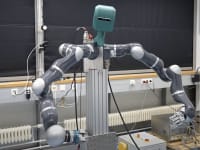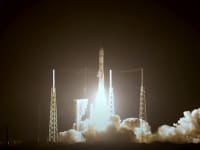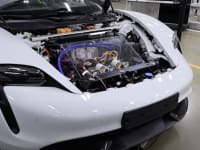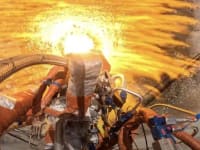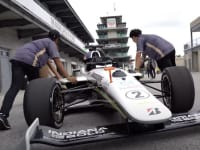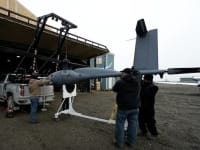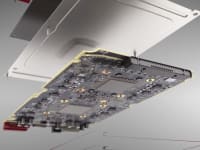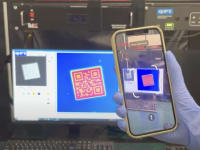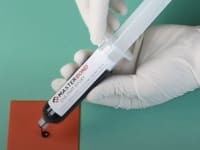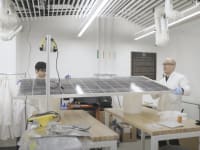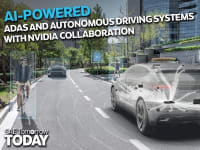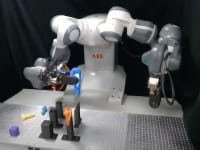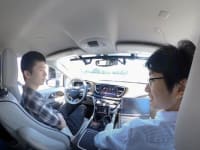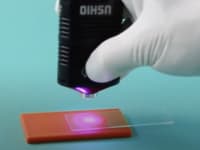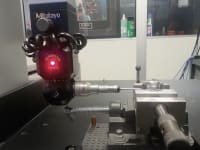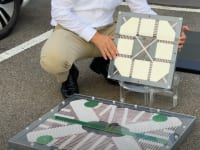61
12,105,170,194,926
-1
3360
30
INSIDER: Test & Measurement
As of 2010, more than a third of all utility meters in the United States used wireless automatic meter reading (AMR) technology – 47 million in all. They make it a lot easier for the utility company...
INSIDER: Test & Measurement
The two-story building on West Commercial Avenue in El Centro, Calif., was built in the 1920s and has withstood four major earthquakes in 1940, 1979, 1987 and 2010, but it may not be...
News
The First Entirely All-Carbon Solar Cell
Stanford University engineers have developed the first solar cell made entirely of carbon - a promising alternative to the expensive materials used in photovoltaic devices today. The thin-film prototype is made of carbon materials that can be coated from solution - a technique that has the potential to...
Question of the Week
Will We Be a "Spacefaring Nation?"
NASA's Chief Technologist Mason Peck delivered the keynote address, "Technology and the Future," at the NASA Innovative Advanced Concepts (NIAC) Fall Symposium in Hampton, Virginia. The speech showed that Peck envisions a "spacefaring nation" where our relationship with spacecraft, space hardware, or data from...
News
Sprayable Paint Protects NASA Spacecraft Components
NASA technologists have developed a low-cost, low-mass technique for protecting sensitive spacecraft components from outgassed contaminants.
The team has created a patent-pending, sprayable paint that adsorbs the gaseous molecules and stops them from affixing to instrument components. Made of...
News
Microdevice Mimics Dog's Nose to Detect Explosives
Researchers at the University of California, Santa Barbara have designed a detector that uses microfluidic nanotechnology to mimic the biological mechanism behind canine scent receptors. The device is both highly sensitive to trace amounts of certain vapor molecules, and able to tell a specific...
News
Glove Keyboard Enables Use of Devices With One Hand
Computer engineering students at The University of Alabama in Huntsville have designed a tool that could revolutionize new ways of using electronic devices with just one hand. It’s called a Gauntlet Keyboard, a glove device that functions as a wireless keyboard. Instead of tapping keys on a...
News: Electronics & Computers
Multi-Walled Carbon Nanotubes Could Become Electronic Interconnects
Using a new method for precisely controlling the deposition of carbon, researchers have demonstrated a technique for connecting multi-walled carbon nanotubes to the metallic pads of integrated circuits without the high interface resistance produced by traditional fabrication...
News
Hydrogels Bio-Bots Walk on Their Own
Miniature “bio-bots” developed at the University of Illinois are made of hydrogel and heart cells, but can walk on their own. The key to the bio-bots’ locomotion is asymmetry. Resembling a tiny springboard, each bot has one long, thin leg resting on a stout supporting leg. The thin leg is covered with rat...
Question of the Week
Will Drones Beam Wi-fi from the Skies?
If a future hurricane causes power outages, regulators say they
could float wireless antennas from balloons or drones to solve problems with
telecommunications networks. The Federal Communications Commission is exploring the use
of such airborne technology to restore communications after disasters....
News
Vortex Surfing Could Be Revolutionary Fuel Saver
Migrating birds, NASCAR drivers and Tour de France bicyclists already get it. And now the Air Force is thinking about flying gas-guzzling cargo aircraft in formation -- 'dragging' off one another -- on long-haul flights across the oceans.
News: Photonics/Optics
Artificial Lens Resembles Natural Eye
Drawing heavily upon nature for inspiration, a team of researchers has created a new artificial lens that is nearly identical to the natural lens of the human eye. This innovative lens, which is made up of thousands of nanoscale polymer layers, may one day provide a more natural performance in implantable...
News
NASA Engineers Build UAV Systems for Wildlife Surveillance
Engineers at NASA's Kennedy Space Center in Florida are building a fuel cell-powered unmanned aerial vehicle and support systems to perform missions such as wildlife surveillance around the complex.The aircraft will carry a small camera and be able to capture precise images and statistics...
News
Thumbtack-Sized Distance and Motion Sensor Serves as Pocket Radar
Today’s parking assistant systems enable drivers to safely park their cars even in the narrowest of gaps. Such sophisticated parking aids – as well as manufacturing robots – that require millimeter-precision control rely on precise all-around radar distance measurement....
News
New Communications System Allows Vehicles to 'Talk' With Roads
Someday, your auto and the roadway will be in constant communication and able to suggest route changes to avoid accidents, construction, and congestion; coordinate your vehicle with signal lights, other vehicles, and lane markers; and let you know where you can park. Right now, a fleet...
News: RF & Microwave Electronics
Technique Uses GPS Signals to Gauge Hurricane's Strength
University of Michigan engineering researchers are working on a global satellite project that would help predict the intensity of a hurricane while it is developing. In coordination with NASA, Michigan Engineering Professor Chris Ruf is working on the Cyclone Global Navigation Satellite...
Question of the Week
Will That Be Our Best Idea?
A new asteroid-deflecting idea proposes that paintballs shot into space could prevent a dangerous asteroid from colliding with Earth. The initial force from the paintballs would veer the asteroid slightly off course. The paint resulting from the splattered pellets would more than double the asteroid's sunlight...
News
Ear's 'Natural Battery' Powers Implantable Electronic Device
For the first time, researchers power an implantable electronic device using an electrical potential — a natural battery — deep in the inner ear.The devices could monitor biological activity in the ears of people with hearing or balance impairments, or responses to therapies....
News
Device Uses Heartbeat to Power Pacemaker
In a study presented at the American Heart Association’s Scientific Sessions 2012, an experimental device converted energy from a beating heart to provide enough electricity to power a pacemaker. The findings suggest that patients could power their pacemakers — eliminating the need for replacements when...
News
Analysis Helps Solve Mysteries of Cracks and Stresses
Diving into a pool from a few feet up allows you to enter the water smoothly and painlessly, but jumping from a bridge can lead to a fatal impact. The water is the same in each case, so why is the effect of hitting its surface so different?
News
Computer Simulation Aids Secure Carbon Dioxide Storage
The race is on to develop the most secure solution for storing CO2 in the Earth’s crust. A Norwegian company, Numerical Rocks AS, has developed a method for studying precisely how this greenhouse gas is bound inside rock.
News
Computational Model Identifies Ways to Improve Plant Oil Production
Using a computational model they designed to incorporate detailed information about plants’ interconnected metabolic processes, scientists at the U.S. Department of Energy’s Brookhaven National Laboratory have identified key pathways that appear to “favor” the production of...
News
Researchers Develop All-Carbon Solar Cell
Stanford University scientists have built the first solar cell made entirely of carbon, a promising alternative to the expensive materials used in photovoltaic devices today. Unlike rigid silicon solar panels that adorn many rooftops, Stanford's thin film prototype is made of carbon materials that can be...
Question of the Week
Will We See a Greater Use of 'Beaming' Avatar Technology?
Researchers successfully tested a beaming technology that
allowed humans and a rat to interact through virtual reality avatars. Using digital
representations of themselves, the researchers enabled the rat to interact with a
rat-sized robot controlled by a human participant in a...
News
Measuring the Impact of Football Concussions
Concussions are arguably football's most prominent injury, but they're also its most mysterious. With the help of Stanford University's football team, a group of Stanford doctors and neuroscientists is working to quantify the head trauma that players sustain during a game.
News
Soldiers Begin Training With Virtual Battlespace 2 Simulator
A Fort Jackson battalion is piloting a new training tool that will look familiar to many new soldiers. Virtual Battlespace 2, or VBS2, offers battlefield simulations that allow instructors to create new scenarios and engage the simulation from multiple viewpoints. The squad-management...
News
R&D Effort Underway to Modernize Abrams Tank
Over the past decade the only thing that has been able to slow the Army's premier combat vehicle hasn't been enemies on the battlefield, but rather the technological advancements added to the platform. While every vehicle is designed to have Space, Weight, and Power (SWaP) margin for incremental...
News
Army Fields Next-Generation Radar
The U.S. Army has begun fielding new radar systems to protect forward- deployed forces. Several next-generation, mobile Counter Target Acquisition, or CTA radar systems are now able to provide soldiers with a 360-degree protective envelope or warning capability against incoming enemy rocket, artillery and mortar...
News: Energy
Quick Cook Method Turns Algae into Oil
Michigan Engineering researchers can "pressure-cook" algae for as little as a minute and transform an unprecedented 65 percent of the green slime into biocrude. "We're trying to mimic the process in nature that forms crude oil with marine organisms," said Phil Savage, an Arthur F. Thurnau professor and a...
Top Stories
Blog: Manufacturing & Prototyping
2025 Holiday Gift Guide for Engineers: Tech, Tools, and Gadgets
INSIDER: Research Lab
Scientists Create Superconducting Semiconductor Material
Blog: Software
Quiz: Materials
Blog: Aerospace
Tech Briefs Wrapped 2025: Top 10 Technology Stories
Blog: Manufacturing & Prototyping
Webcasts
 Upcoming Webinars: AR/AI
Upcoming Webinars: AR/AI
The Real Impact of AR and AI in the Industrial Equipment Industry
 Upcoming Webinars: Motion Control
Upcoming Webinars: Motion Control
Next-Generation Linear and Rotary Stages: When Ultra Precision...
 Upcoming Webinars: Energy
Upcoming Webinars: Energy
Hydrogen Engines Are Heating Up for Heavy Duty
 Podcasts: Medical
Podcasts: Medical
How Wearables Are Enhancing Smart Drug Delivery
 Podcasts: Power
Podcasts: Power
SAE Automotive Podcast: Solid-State Batteries




